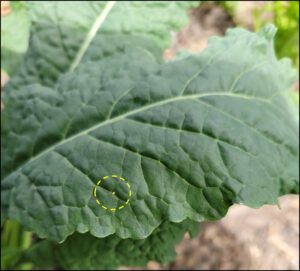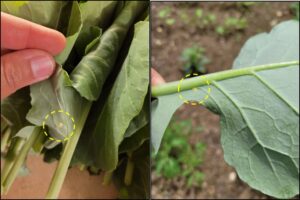It’s around that time when your first crop of tender greens may be close to ready for first harvest! Growing kale, arugula, collard greens, and lettuce this year, I’ve been keeping a hawk’s eye out for signs of caterpillar activity.
In the Lafayette area, I’m beginning to see signs of common caterpillar pests of these crops – individual eggs laid by the imported cabbageworm (Figure 1), and egg masses of cross-striped cabbageworms (Figure 2). Once they hatch, these common caterpillars will destroy/defoliate your crops if given the chance! Hopefully these images will help you recognize ‘who’ these eggs belong to and decide how to best manage them: either by squishing/removing them by hand if you have a small garden, or spraying with appropriate insecticides if you have a larger home or commercial garden.
Watch a recording of “Caterpillars and other insect pests of cole and kale crops” (starting at 19 minutes, 50 seconds) from Purdue Extension’s Vegetable Farming Webinar Series earlier this year to learn more about how to identify common caterpillars, as well as differences between feeding damage caused by caterpillars versus flea beetles and thrips on cole and kale crops.
Home gardeners can target caterpillars on cole and kale crops with products like Monterey Bug Buster-O® (active ingredient: pyrethrin), which is OMRI-listed for organic use, or Spectracide® Triazicide® Insect Killer for Lawns and Landscapes Concentrate (active ingredient: gamma-cyhalothrin), among others. Commercial producers can visit the Midwest Vegetable Production guide online to find insecticide options for these crops. Please always read pesticide labels carefully, observe the proper pre-harvest interval (PHI) for the crop you are spraying, and remember, there are beneficial insects in your garden too, so please use insecticide products judiciously!

